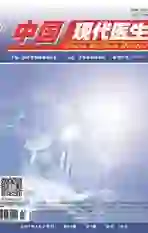有氧运动对阵发性房颤射频消融术后患者左心结构、功能及运动耐力的影响
2021-04-29曹培红孙春梅葛卫力
曹培红 孙春梅 葛卫力
[摘要] 目的 探討有氧运动对阵发性房颤(AF)射频消融术后患者左心结构、功能及运动耐力的影响。 方法 选取2018年1月至2019年2月我院心内科住院治疗的行射频消融术的阵发性AF患者110例,随机分为干预组与对照组,每组各55例。两组患者术后均行常规华法林钠片或低分子肝素等抗凝治疗。对照组患者术后给予常规干预措施,干预组患者术后3 d在对照组基础上加用有氧运动干预,两组均干预1年。观察两组术后3 d和干预1年后左心结构、功能和运动耐力指标的变化,并比较AF的复发率。 结果 干预1年后,两组LAD水平均较术后3 d明显下降,LVEF水平较术后3 d明显上升(P<0.05或P<0.01),且干预1年后干预组下降或上升幅度较对照组更显著(P<0.05);两组患者6 min步行试验较术后3 d明显上升(P<0.05或P<0.01),且干预1年后干预组上升幅度高于对照组(P<0.05)。干预1年内,干预组患者复发4例(7.27%),对照组患者复发12例(21.82%),干预组患者的复发率明显低于对照组,差异有统计学意义(χ2=4.680,P<0.05)。 结论 有氧运动用于阵发性AF射频消融术后患者不仅可改善左心结构和功能,还可提高运动耐力,且其远期效果亦较确切,能降低其复发率。
[关键词] 房颤;射频消融术;有氧运动;左心结构;运动耐力;复发
[中图分类号] R541.7 [文献标识码] A [文章编号] 1673-9701(2021)07-0010-03
Impacts of the aerobic exercise on left ventricular structure, function and exercise tolerance of patients with paroxysmal atrial fibrillation after radiofrequency ablation
CAO Peihong SUN Chunmei GE Weili
Department of Cardiology,Taizhou Hospital of Zhejiang Province affiliated to Wenzhou Medical University, Taizhou 317000,China
[Abstract] Objective To explore the impacts of the aerobic exercise on left ventricular structure, function and exercise tolerance of patients with paroxysmal atrial fibrillation (AF) after radiofrequency ablation. Methods From January 2018 to February 2019, a total of 110 patients with paroxysmal AF undergoing radiofrequency ablation were randomly divided into the intervention group(n=55) and the control group(n=55). Two groups of patients were routinely anticoagulated with warfarin or low molecular weight heparin. Patients in the control group were given routine intervention measures after operation, while patients in the intervention group were given aerobic exercise intervention on the basis of the control group 3 days after operation, and both groups were intervened for 1 year. The changes of left ventricular structure, function and exercise tolerance indexes were observed three days after operation and 1 year after intervention, and the relapse rate of AF was compared between the two groups. Results After 1 year of intervention, the LAD levels of the two groups decreased significantly compared with those of 3 days after operation,and the LVEF level was significantly increased compared with that of 3 days after operation(P<0.05 or P<0.01), and the decrease or increase range of the intervention group was more significant than that of the control group after 1 year of intervention(P<0.05). The 6 minutes walking tests of the two groups were significantly higher than those of 3 days after operation(P<0.05 or P<0.01), and the increase of the intervention group was more significant than that of the control group after 1 year of intervention(P<0.05). Within 1 year of intervention, 4 patients(7.27%) in the intervention group and 12 patients (21.82%) in the control group relapsed, and the relapse rate of the intervention group was significantly lower than that of control group, with statistically significant difference(χ2=4.680, P<0.05). Conclusion Aerobic exercise not only improves the structure and function of left heart, but also increases exercise tolerance, and its long-term efficacy is also accurate, which reduces its relapse rate.
[Key words] Atrial fibrillation; Radiofrequency ablation; Aerobic exercise; Left ventricular structure; Exercise tolerance; Relapse
房颤(Atrial fibrillation,AF)是一种常见的室上性心律失常疾病,如不及时处理,其病情常反复发作会引起左心结构和功能,影响患者的运动耐力及心功能异常[1-2]。射频消融术是目前治疗阵发性AF常用的治疗方法,具有创伤轻微、术后恢复速度快和术后并发症低等多种优点,已成为治疗AF的首选方案[3-4]。但射频消融术术后仍需进行积极康复锻炼逆转左心结构和功能异常,提高其运动耐力,改善其心功能。研究发现有氧运动对提高增强心血管系统功能具有积极的促进作用,但其用于阵发性AF射频消融术后国内外报道较少[5-6]。本研究探讨有氧运动对阵发性AF射频消融术后左心结构、功能及运动耐力的影响,现报道如下。
1 资料与方法
1.1 一般资料
选取2018年1月至2019年2月我院心内科住院治疗的行射频消融术的阵发性AF患者110例。采用随机数字表法将110例患者分为干预组和对照组,每组各55例。两组患者的性别、年龄、体质量指数和病程比较,差异无统计学意义(P>0.05),具有可比性。见表1。纳入标准[7]:①符合欧洲心脏协会制定的阵发性AF诊断标准[8],均经心电图和(或)Holter证实为阵发性AF;②年龄35~70岁。排除标准[9]:①持续性房颤;左心房舒张末期内径>60 mm;②合并有瓣膜性心脏病、扩张型心肌病和左心功能严重障碍者;③甲状腺功能亢进或酒精引起继发性AF者。本研究经医院医学伦理委员会批准,纳入患者均签署知情同意书。
1.2 方法
两组患者术后均常规给予华法林钠片(齐鲁制药有限公司,批准文号:国药准字H37021314,规格:2.5 mg/片)或低分子肝素(河北常山生化药业股份有限公司,批准文号:国药准字H20063910,规格:4100 IU)等抗凝治疗。对照组患者术后给予心理安慰、认知教育、适当的运动锻炼和心电图检测等常规干预措施。干预组患者术后3 d在对照组基础上加用有氧运动干预,以步行运动为主,选择餐后1 h进行,先缓慢步行5 min热身,后进行快步走0.5 h左右,结束后再缓慢步行5 min左右,3次/周,步行运动时注意监测心率和呼吸困难指数,如心率>160次/min或呼吸困难指数>4分,立即减缓步行速度或停止运动。两组均干预1年。
1.3 观察指标
观察两组患者术后3 d和术后1年左心结构、功能和运动耐力指标的变化,并比较AF的复发率。
1.3.1 左心结构和功能指标评估[10] 采用西门子SC2000心脏彩超测量左心房内径(Left atrial diameter,LAD)和左心室射血分数(Left ventri cular ejection fraction,LVEF)。
1.3.2 运动耐力指标评估[5] 采用6 min步行试验评估其运动耐力。6 min步行试验是要求患者在平直走廊里尽可能快地行走,测定6 min的步行距离,其正常值>550 m。
1.4 统计学处理
采用SPSS 20.0统计学软件处理数据,计量资料用均数±标准差(x±s)表示,采用t检验,计数资料用[n(%)]表示,采用χ2检验,P<0.05为差异有统计学意义。
2 结果
2.1 两组术后3 d和干预1年后左心结构和功能指标比较
术后3 d两组患者LAD和LVEF水平比较,差异无统计学意义(P>0.05)。干预1年后,两组LAD水平均较术后3 d明显下降,LVEF水平较术后3 d明显上升,差异有统计学意义(P<0.05或P<0.01),且干预1年后干预组下降或上升幅度较对照组更显著,差异有统计学意义(P<0.05)。见表2。
2.2 两组术后3 d和干预1年后运动耐力指标比较
术后3 d两组患者6 min步行试验比较,差异无统计学意义(P>0.05)。干预1年后,两组患者6 min步行试验较术后3 d明显上升,差异有统计学意义(P<0.05或P<0.01),且干预1年后干预组上升幅度高于对照组,差异有统计学意义(P<0.05)。见表3。
2.3 两组干预1年内AF的复发率比较
干预1年内,干預组患者复发4例(7.27%),对照组患者复发12例(21.82%),干预组患者的复发率明显低于对照组(χ2=4.680,P<0.05)。
3 讨论
AF是心内科中最常见的心律失常疾病,是指心肌丧失正常有规律的舒缩活动,代之以快速而不协调的微弱蠕动,致使心房失去正常的有效收缩,较快的心率可达350~600次/min,这种快速的心率会使患者产生不同程度的心悸、胸闷和气短等临床症状,其中阵发性较多见。随着年龄增长其发生率也逐渐增加,据统计75岁以上人群的发病率高达10%[11]。由于AF患者常伴随出现血管栓塞、心脏功能衰竭等多种并发症,对患者的身体健康造成较大的威胁,临床死亡率和致残率均较高,早期转复成为窦性心律并予以长期维持是治疗AF的最终目的[12]。射频消融术是目前治疗阵发性AF常用的微创手段,术中将电极导管经静脉或动脉血管送入心腔的特定部位,释放射频电流导致局部心内膜及心内膜下心肌凝固性坏死,达到阻断快速心律失常异常传导束和起源点的介入性技术,近年来已广泛用于临床,并取得了较好的效果[13-14]。但由于阵发性AF患者予以射频消融术治疗后仍有一定的复发风险,且阵发性AF患者行射频消融术前常存在心脏结构和功能异常,运动耐力和心功能等问题[15-16]。因此,对阵发性AF射频消融术后患者仍需予以积极干预改善其心脏结构和功能,提高其运动耐力,降低其复发率。
有氧运动是指人体在氧气充分供应的情况下进行的强度低且富韵律性的运动,具有强度低、有节奏和持续时间较长的特点。有氧运动时心率保持在150次/min左右,此时血液可以供给心肌足够的氧气。这种有氧锻炼氧气能充分燃烧(即氧化)体内的糖分,还不仅可消耗体内脂肪,而且对患者的呼吸、循环和心理状态功能的改善有一定的帮助作用,有助于改善患者的机体体能,尤其对增强心血管系统功能具有积极的促进作用,其特点为低强度运动结合稳定快速心率可有效提高运动耐力、心肺功能,加快血液循环,是增强心肌功能有助于患者康复的重要手段[17-19]。Everett等[20]研究显示,坚持长期低强度的有氧锻炼可以降低房颤的发病风险。本研究结果显示,干预1年后,干预组LAD水平较术后3 d下降幅度,LVEF水平較术后3 d上升幅度较对照组更显著;同时干预组患者6 min步行试验较术后3 d上升幅度较对照组更显著。提示有氧运动用于阵发性AF射频消融术后患者不仅可改善左心结构和功能,而且可提高运动耐力。同时研究还发现干预1年内,干预组患者复发率明显低于对照组。提示有氧运动用于阵发性AF射频消融术后患者远期效果亦较确切,能降低其复发率。本研究有氧运动方式选择步行运动,相对于其他有氧运动方式有适用人群广、安全系数较高、风险低,治疗依从性较高等优势。
综上所述,有氧运动用于阵发性AF射频消融术后患者不仅可改善左心结构和功能,而且可提高运动耐力,其远期效果亦较确切,能降低其复发率。但本研究纳入的病例数偏少且观察时间偏短,必要时需增加病例数及延长观察时间进行深入研究探讨。
[参考文献]
[1] Zhao R,Li D,Zuo P,et al. Influences of age gender and circadian rhythm on deceleration capacity in subjects without evident heart diseases[J].Ann Noninvasive Ele-c trocardiol,2018,20(2):158-166.
[2] Raine D,Langley P,Shepherd E,et al. Effect of catheter ablation on quality of life in patients with atrial fibrillation and its correlation with arrhythmia outcome[J]. Open Heart,2015,2(1):e30-e32.
[3] Wang YP,Kuo TB,Lai CT,et al. Effects of breathing frequency on the heart rate deceleration capacity and heart rate acceleration capacity[J].Eur J Appl Physiol,2017, 115(11):2415-2420.
[4] Schaeffer BN,Rybczynski M,Sheikhzadeh S,et al. Heart rate turbulence and deceleration capacity for risk predic tion of serious arrhythmic events in Marfan syndrome[J].Clin Res Cardiol,2016,104(12):1054-1063.
[5] 陈爱华,宋旭东,杨平珍.房颤射频消融治疗的现状与困境[J].解放军医学杂志,2015,52(2):85-91.
[6] 孙丽娜,杨亚兵,常苹,等.心腔内三维超声辅助下经导管射频消融治疗心房颤动伴造影剂不相容患者的临床分析[J].中国循环杂志,2020,35(2):166-170.
[7] 杨少峰,沈崇文,施超.房颤外科消融治疗的研究进展[J].山东医药,2020,60(5):107-110.
[8] Camm AJ,Lip GYH,De Caterina R,et al.2012 focused update of the ESC Guidelines for the management of atrial fibrillation:An update of the 2010 ESC Guidelines for the management of atrial fibrillation developed with the special contribution of the European heart rhythm association[J].Eur Heart J,2012,33(21):2719-2747.
[9] Gao L,Chen YD,Shi YJ,et al.Value of DC and DRs in prediction of cardiovascular events in acute myocardial infarctionpatients[J].Zhonghua Yi Xue Za zhi,2016,96(19):1519-1522.
[10] 文雯.探讨动态心电图在检测阵发性房颤中的作用[J].临床研究,2019,27(4):27-28.
[11] 黄从新,张澍,黄德嘉,等.心房颤动:目前的认识和治疗的建议-2018[J].中国心脏起搏与心电生理杂志,2018, 32(4):315-368.
[12] Rosati F,Muneretto C,Merati E,et al.Epicardial,biatrial ablation with integrated uni-bipolar radiofrequency technology in standalone persistent atrial fibrillation[J].Innovations(Phila),2018,13(2):114-119.
[13] 成少永,張晓婷,徐雪纯,等.射频消融与药物治疗阵发性房颤复律后心房电机械功能的对比研究[J].解放军医学杂志,2015,40(5):387-390.
[14] 徐海霞,陆齐,黄荫浩,等.阵发性心房颤动患者射频消融术后复发的预测因素分析[J].中国循环杂志,2017, 20(12):883-885.
[15] Yang S,Mei B,Feng K,et al.Long-term results of surgical atrial fibrillation radiofrequency ablation:Comparison of two methods[J].Heart Lung Circ,2018,27(5):621-628.
[16] Im Sung II,Jin CK,Seung-Jung P,et al.Long-term prognosis of paroxysmal atrial fibrillation and predictors for progression to persistnt or chronic atrial fibrillation in the Korean population[J].J Korean Med Sci,2015,30(7):895-902.
[17] Zopf EM,Baumann FT,Pfeifer K.Physical activity and exercise recommendations for cancer patients during rehabilitation[J].Rehabilitation(Stuttg),2014,53(1):2-7.
[18] Kwok CS,Anderson SG,Myint PK,et al.Physical activity and incidence of atrial fibrillation:A systemytic review and meta-analysis[J].Int J Cardiol,2014,177(2):467-476.
[19] Gierat-Haponiuk K,Haponiuk I,Szalewska D,et al.Effect of complex cardiac rehabilitation on physical activity and quality of life during long-term follow-up after surgical correction of congenital heart disease[J].Kardiol Pol,2015,73(4):267-273.
[20] Everett BM,Conen D,Buring JE,et al.Physical activity and the risk of incident atrial fibrillation in women[J].Circ Cardiovasc Qual Outcomes,2011,4(3):321-327.
(收稿日期:2020-08-25)
